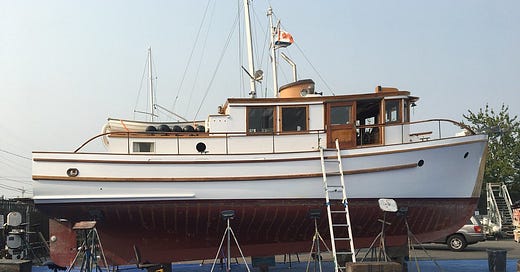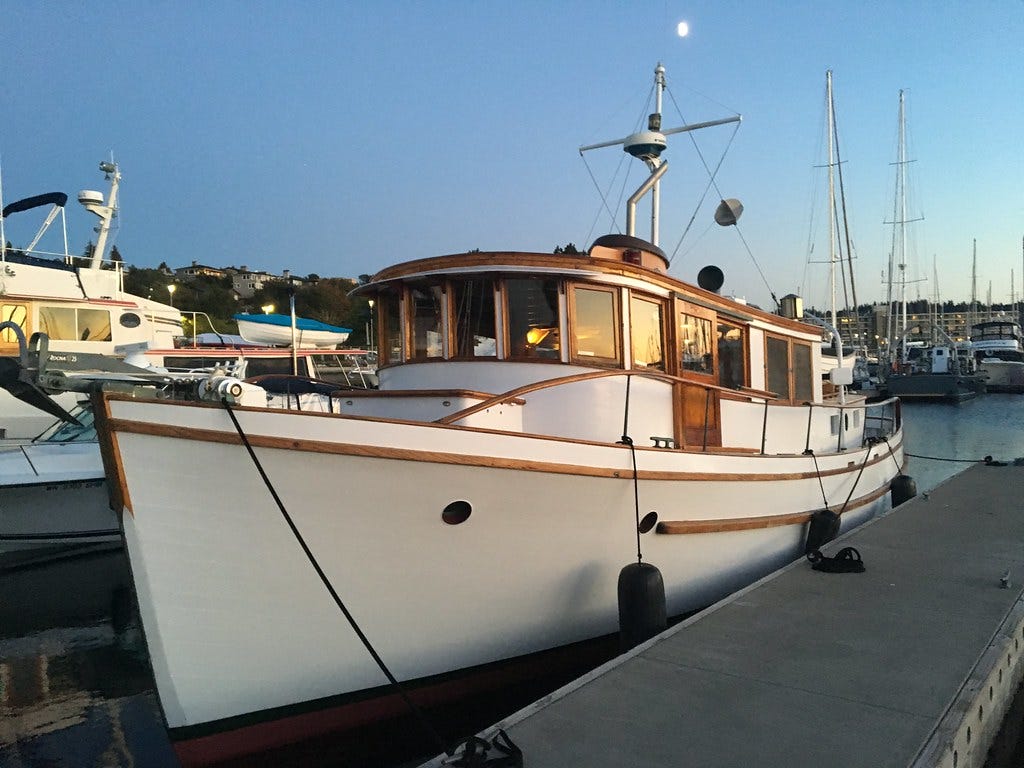A traditional wooden boat, meaning one built plank-on-frame, is formed from thousands of individual pieces, all with their own name and purpose. Keel, stem, horn timber, deadwood, sternpost, garboard, floor, frame, plank, butt, bilge stringer, ceiling, sheer clamp, shelf, carlin, deck beam, margin plank, king plank, and countless others, all which vary from region to region and builder to builder. Wooden boats built in this manner are like violin bows, or saddles - things invented and made, not engineered or produced. They have developed through centuries of convergent evolution.
The feluccas of the Mediterranean and the faerings and seksrings of Scandinavia evolved two thousand miles apart yet with similar form and purpose. As builders from those regions came to America, the designs evolved further into the fishing boats of the Pacific Northwest, built by immigrants from Norway and Sweden, and the Monterey clippers of California, created by Italians who came to San Francisco for the gold rush - boats which are similar in design and purpose, but different in detail.
These designs continued to develop over the first half of the twentieth century. The double-ended trollers and gillnetters of Oregon, Washington, and British Columbia grew larger and lost their pointed sterns so that they could haul and carry more fish, and to accommodate the larger engines needed as the fishing grounds moved farther offshore. The hulls grew deeper and beamier, and the sterns wider as the form evolved from the narrow, efficient lines of craft designed for sail and oar to sturdy diesel engine-powered boats suitable for the Northwest.
Skookum Maru is the product of that evolution - a hull form that can be traced over centuries to be refined on the drafting board of her designer, Ed Monk Sr. then formed from thousands of pieces of wood by craftsmen in Kobe, Japan. And those thousands of pieces were held together by iron screws, bolts, and nails. All material things are temporary, but iron in salt water is more temporary than most. After sixty years, the fasteners holding Skookum Maru together had rusted away, leaving her as not a boat so much as a set of independent pieces traveling together in a boat-shaped assemblage.
Skookum Maru needed to be refastened, a task which would require the replacement of some two thousand-odd screws, nails, and bolts fastening the planks to the frames. So after a three-day trip from Blaine, Washington August of 2018, we hauled out at Canal Boatyard in Seattle. Mark Lerdahl, who had worked on our other boat, Petrel, the previous year, did all of the skilled work while I scraped paint, ran errands, hammered on things when needed, and learned as much as I could from him.
In an ideal world we would have liked to refasten the boat with silicon bronze screws, which would last longer than the original fasteners. However given the state of the old fasteners we would not be able to remove the iron nails - they would have to remain in the wood, next to the new screws. Dissimilar metals in close proximity under water can cause a variety of bad things to happen, so after much thought and indecision we decided to use galvanized screws instead. They may not last as long as bronze but they will last longer than I will, and that will have to be long enough.
Refastening is a big project. New pilot holes were drilled for each of the screws - two to a plank at each frame - and the screws were coated with bedding compound, wrapped with a twist of cotton, placed in the waiting holes, and tightened. Then Mark and I made cedar plugs to cover the screw heads, glued them in place, and cut them flush with a slick - a large, two-handed chisel. It took us days of monotonous work but with steady effort we made progress. Less than a month later Skookum Maru was ready to go back in the water with a fresh coat of bottom paint and a new green boot stripe.
We launched her on a Friday afternoon in early September. After nearly two decades of work, first with Perihelion, the Huckins that I tried and failed to restore, then with Petrel, the fishing boat that I restored but which proved to be unsuitable for cruising as a family, we had our boat.





